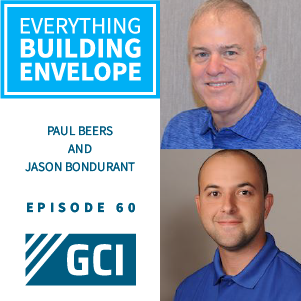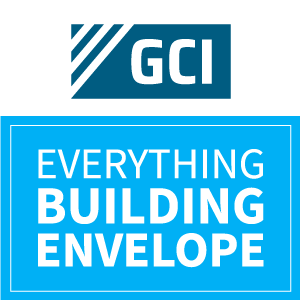
About The Everything Building Envelope Podcast: Everything Building Envelope℠ is a dedicated podcast and video forum for understanding the building envelope. Our podcast series discusses current trends and issues that contractors, developers and building owners have to deal with related to pre and post construction. Our series touches on various topics related to water infiltration, litigation and construction methods related to the building envelope.
https://www.everythingbuildingenvelope.com
*** Subscribe to the show and leave us a Review on ITunes!
Paul: Hello, everyone, welcome back to the “Everything Building Envelope” podcast. I’m Paul Beers managing member and principal with GCI Consultants. I’ll be your host today. I’m really excited to welcome back a repeat guest. One of our consultants who’s been on before obviously, Jason Bondurant. Jason, really glad to have you back. Welcome.
Jason: Thanks, Paul. Thanks for having me again.
Paul: We’ve got an interesting topic that we’re gonna talk about today, which is due diligence, and then we’re gonna talk specifically about Due Diligence of the Exterior Building Envelope. So, Jason you’re a repeat guest, but why don’t you tell everybody just a little bit about yourself, and then we’ll jump into the topic.
Jason: So, I’m a senior consultant with GCI. I’ve worked for GCI for about 7 years and mainly I deal with forensic investigations, problems with existing buildings.
Paul: So due diligence is something that’s right up your alley?
Jason: Yeah.
Paul: So, let’s define due diligence and then specifically Due Diligence of the Building Envelope. So, Jason, can you just tell us a little bit about what due diligence is and maybe some context about when it’s done.
Jason: So, the main purpose of a due diligence, do building envelope inspection is to assess the condition of the building envelope at a property. And the main thing that we’re looking for is to identify any deficiencies which might require repair or replacement. And when we say building envelope, we’re basically referring to the exterior skin of the building. So, the exterior wall systems which might be brick or stucco glazing systems like storefronts, curtain walls, sliding glass doors, waterproofing systems on balconies or plaza decks, and the roofing systems on the roof of the building.
So basically, any issues with the exterior skin of the building is what we’re looking for. And I think it’s important to point out that it’s not the same thing as an inspection for code compliance or construction defect inspection. We’re basically just looking for any issues with the condition of the building, which are not necessarily the same as code issues. And the last, probably most important part and most important reason for doing this inspection is to determine, “What’s an approximate order of magnitude cost for the issues that we’ve identified?” The cost of any repair or placement to address those issues.
Paul: So, this is obviously, done when a building is…typically done maybe when a building is changing hands. And when you were describing the process, I was thinking, home inspection on steroids. And what I mean by that is obviously, it’s a much bigger building, but it’s kind of the same concept, isn’t it? Where the property transaction is occurring, it’s kind of like, “Buyer beware, they need to really understand what they’re getting.” Does that seem like it’s kind of the way this is set up?
Jason: Yeah, so it’s pretty much exactly the same as a home inspection that you would get in connection with the sale of a home. And it includes other types of structures, such as multifamily residential buildings, commercial buildings, like hotels, office buildings. I would say that, like you said, it’s just on a greater scale for the most part. Typically, home inspectors that they will just deal with residential single-family homes. And at this level, we’ll deal with all different types of structures.
And the purpose of having this done in either case, is, again to identify any of these issues, but really for the purpose of negotiating a lower price, or requesting a credit, or requesting that the seller address any of these issues prior to closing. And, of course, some instances the findings of this type of assessment could lead to one party backing out of the deal.
Paul: Yeah, I remember years ago looking at a building for one of our bigger clients, and he was actually…had sold a portfolio of buildings in New York and was transferring some of those assets to Florida. And one of the buildings that we looked at was a barrier EIFS system, EIFS, E-I-F-S, Exterior Insulation, and Finish System, which have been known to have problems. And we went and looked at this building and it was over in the Tampa Bay area. It was a two, three-story office building. And there was obvious some pretty severe problems with water intrusion and water damage inside the walls. And were actually gonna talk about this a little bit. We went to a higher level of scrutiny and we determined that the problems were pretty severe, and they ended up, because of that, not buying the building. And obviously, they wanted to buy the building and the seller wanted to sell it, but they were really grateful that we helped them avoid making a big mistake. So, you’re not there to blow up the sale. But sometimes that happens, as you mentioned.
So, let’s just talk a little bit about the first initial survey and the deliverable. So, and also the timeframe. This is always happening quickly. So, what do we do, Say we get contacted to go look at a 200 room hotel? What would we do?
Jason: Well, so, and before we get into the details of the methodology, I think it is important to point out that the methodology that we use is based upon industry standards. There is, in ASTM standard, it’s called ASTM E2018, which is called the Standard Guide for Property Condition Assessment. And it kind of lays out this whole process for a due diligence inspection. I think it’s important to note, however, that typically these inspections do include other things besides the building envelope such as sight drainage, landscaping, air conditioning, electrical systems, structural systems, life safety, fire protection. So, here at GCI, we’re only dealing with the envelope of the building and we don’t look at those other items.
There are some firms that will cover everything. And occasionally GCI will assist those firms as only investigating the building envelope. So, I think it’s just important to note that the inspection does typically include other factors. So, for the building envelope portion, the procedure typically follows another standard. It’s by the American Society of Civil Engineers. It’s called The Guideline for Condition Assessment of The Building Envelope. And these types of assessments will typically fall under the preliminary category, which is essentially a visual inspection only. And the general methodology that it lays out includes reviewing any documents that we can receive prior to the inspection, performing an inspection of the property, and interviewing any representatives of the properties, such as managers or maintenance personnel, and preparing a report with our recommendations and cost estimate.
So, if we get a call, I’m getting back to your question, to assess a property, typically the first thing that we wanna do… And like you mentioned, it’s usually a very tight timeline. They have a hard date when they need to have this information by so they can make their decision. So, the first thing that we wanna do is gather as much information as we can prior to doing the inspection, which is this initial document review phase. So, we would ask them if they have construction documents, or maintenance records or leak logs of the building.
And I’ll say that the amount of information that we get varies widely from project to project and typically will receive very little. Which is why I always encourage any managers or maintenance personnel that we deal with, to keep as detailed records as they can, because it just helps us down the road when we’re trying to get an idea of the history of the building. So that’s kind of the first step, and obviously, schedule the site inspection as soon as possible.
Paul: And then when we’re out there, we look at all the various elements and produce the report and the cost estimate. So, can that lead to additional services?
Jason: Yeah, absolutely. It just depends on what we’re able to find during the inspection. So, during the inspection, it’s typically visual-only. So, the scope of the visual inspection is typically limited by the amount of time that we have. So, for many properties, it might just be a one-day inspection. For some larger properties, it might be several days. But we’re limited by the amount of time that we have. So we will walk around a representative sample of exterior and interior areas and just look for any obvious deficiencies that we can see with the building envelope, but also look for any evidence of distress that could be concealed. Things like cracks, or evidence of water intrusion and some interior areas.
And occasionally, depending on the type of systems that we’re looking at, we may not be able to see everything on that first day at the site. And we may recommend, as part of our preliminary report, to do some additional digging. And that can mean quite literally digging into decks or walls to see concealed weather barriers or waterproofing systems. Or that might also mean performing water testing, or even gathering samples and sending them to labs to do additional analysis there. There have been some instances where these additional steps, while they do take additional time and money, they are warranted because there was a real concern that there was concealed issues there that they wouldn’t have known about otherwise.
Paul: Yeah, they wanna go into these transactions with their eyes wide open. I remember you and I had worked on a project within the last six or nine months where the buyer was buying a building, and he knew there were issues with the facade, and he knew that there was gonna be significant repairs needed. And that was all part of his plan was, you know, “Do the repairs need to be done now or can they be done in five years from now? How much is it gonna cost? What’s the magnitude?” And I was really surprised. I thought he wasn’t going to buy the building, but he did because he liked the property so much. And he had more… I don’t know what the financial terms were, but he was more interested in having a plan going forward once he acquired the property. And doing the assessment upfront, allowed him to do that and gave him the information he needed to proceed. So, Jason, we do get into situations I think a lot as from the building envelope situation where maybe somebody else identifies issues and then we get brought in a hurry to try and figure out what’s going on, is that right?
Jason: Yeah. And I think you kind of highlighted why the last part of this with the report is getting this order of magnitude cost estimate. And I think you highlighted why that’s so important because a lot of people will approach these types of transactions, as this is an investment for them. And they need to be aware of all the issues and what it might cost to address those issues. And they’ll have to decide based on that information, whether or not it’s worth the investment, so it is important to be able to have that.
And our recommendations for repair or replacement might include regular maintenance type issues, or it might include actual replacement, like let’s say, you know, we inspect a property and in our opinion that the roof has exhausted its useful life and it’s leaking and needs to be replaced as soon as possible. And usually, for these kinds of things, there’s some type of term period that we’re looking at. So, they want to know, within the next five years, and within the next 10 years, what are the big-ticket items that they’re gonna need to address these issues?
Paul: So, Jason, Building Envelope Assessments are not always part of Property Condition Assessments, are they?
Jason: Well, I think they should be, and I think they usually are, but I think they’re not always approached with the same level of detail and the same expertise that we typically would bring to them. So, like when you, just going back to like the home inspector example for a single-family home purchase, you’re gonna have someone that’s gonna come out and inspect the house. And typically you’ll just have one guy that’s gonna look at everything, and he’s more of a generalist, so he might not be a stucco expert or a roof expert, but maybe he knows enough about stucco to know if there’s a lot of cracks in the stucco, that’s a problem. Or, if there’s issues with the drip edge on the roof, or maybe he can identify some of these obvious issues, but maybe as less equipped to look at some of these if there are any potential concealed issues or are just not able to look at it through the same lens that we are. So, I think they all are normally included, just not to the same extent that we would look at them.
Paul: Yeah, sometimes, there’s unanticipated issues that you really would have been better off to uncover ahead of time. I remember a hotel project we worked at in the Caribbean a few years back that had a due diligence survey, and I think they even had somebody look at the envelope. And they came out of it, saying they needed to replace a bunch of windows that they were wood frame and they were rotting. And we came in after the fact, we were hired to help them with the actual doing quality control and whatnot on the roof and selecting replacement windows.
We went down there we took a window out just as a kind of the get started part, and the walls that the window…the exterior walls were a disaster. The whole place smelled like mold. The walls had all kinds of water intrusion. And it really messed them up. They had big plans for renovating this property and they were gonna add an extra story to the building and they were gonna do all this stuff. And they missed going in all these issues. And they had to address them once they figured out what was on and they ended up not being able to do the renovations and the upgrades that they wanted to and they ended up selling the property once they got it in decent condition. So that was a example of where better due diligence with respect to the envelope, building envelope, would have really helped them.
Jason: Yeah, I’ve also gotten involved in other situations where the buyer may have gotten their own firm to do their own assessment and seller brought us in or got someone else to do an assessment. And sometimes maybe one party feels like the other is not being reasonable about certain things like maybe their firm is telling them that all the balconies need to be demolished and rebuilt or something like that. And maybe the other side comes in and says, “Well, that’s not very reasonable. We feel like there’s a repair that could address some of the issues here. That’s not gonna be as costly.” And so, we do run into that sometimes where there are differing opinions about something.
Paul: Yeah. And then another thing that comes to mind is we’ve also done property condition assessments for properties being sold after weather events. And I think of a project in Houston that we looked at that had all kinds of water intrusion issues where the seller was saying they had addressed it and was saying it wasn’t that bad. The buyer who retained us thought, maybe otherwise. And we went in and actually did, you know, it was a big building at swing stages and we did feel that water infiltration, testing, and whatnot, we confirmed that the problem was worse than advertised. And that was another one where the sale didn’t go through. So sometimes you’ve gotta be more thorough and you spend a lot of money, but that’s kind of what you need to do to get credible information.
Jason: Well, and I think you bring up… you remind me of another thing that we see sometimes too is before we go in and do our assessment. We do our information gathering maybe we don’t get much, we go interview the people at the site and we get the feeling like maybe they’ve been coached a little bit on what to tell us. And you find out later or the day before they replaced all the ceiling tiles on the top floor of the building to try to hide evidence of roof leak, and or maybe other cosmetic repairs were done, replace interior paint in some areas or stuff like that, just to try to hide some of these issues, which will eventually evidence themselves again in the future. So, you really do have to have somebody that knows what they’re looking at when it comes to this stuff.
Paul: And that’s another thing you’ve mentioned the standards that we use the ASTM E2018 and the AFC E3014 for condition assessments and those for us or anybody else, I don’t see them used frequently, but those are really good because it gives you a systematic way of going through and looking at everything. It’s almost like a really high-end checklist. Now you’ve got to be knowledgeable and whatnot. But how important is it to have something like that, Jason instead of just going out there with a camera and a pad of paper and walk around and see what you see?
Jason: well, you have to follow the process. And I think…I’ll say that the process is very logical. And if you sat down and really planned it out yourself not even knowing that those documents existed, you would probably come up with a process that was very similar. But it is important to follow that process and to go step-by-step, and to do each step before moving on to the next one. Because just as an example I mentioned for the site inspection, we were typically limited by the amount of time that we have on the site. So, let’s say we have a day to inspect a building, maybe it’s a 20-story building, it’s a big building, and there’s no way that we could inspect everything in a day. So obviously, some things are going to be left out.
Now try to look at areas that are representative of all the different conditions on the building. But, again, we’re limited by the amount of time. If you have followed the process, before even going to the site, you’ve done some initial information gathering and maybe you would’ve learned based on a report from an engineer 10 years ago, that there was a major issue with the pool deck 10 years ago, and they did some repairs. Or maybe you find there was an issue with the pool deck 10 years ago, and there’s no evidence that any repairs were done in the document or in your conversations with people leading up to the inspection. Well, now you know when you go to the inspection, this is something you have to look at really closely, maybe this is something that you wanna devote more time to. So, by following that process, it’s laid out in a way it is for a reason. And it is important to follow that methodology.
Paul: Well, Jason, this is a really interesting topic. And I think it’s gonna resonate with some of our listeners, because it’s important that if you are going into transaction, you know, what you’re buying. And, of course, one of the biggest problems buildings can have is to have problems with the exterior building envelope, like water coming in, and all the nasty things that accompany that. So, thank you, for sharing your wisdom with us. And I look forward to having you back to the next podcast. I know it’ll be a different topic but thank you so much for coming on today.
Jason: Thanks for having me. It was fun.
Paul: So, in closing, I’d like to thank everybody for listening to our podcast today. If you’d like to get more information about GCI Consultants or our services. Our website is www.gciconsultants.com, and we’re on all the social media channels. If you’d like to call us about a specific item or you can reach us at 877-740-9990 for any of your building envelope related needs. Thank you once again for listening. I look forward to the next time on “Everything Building Envelope” podcast. This is Paul Beers saying so long.


